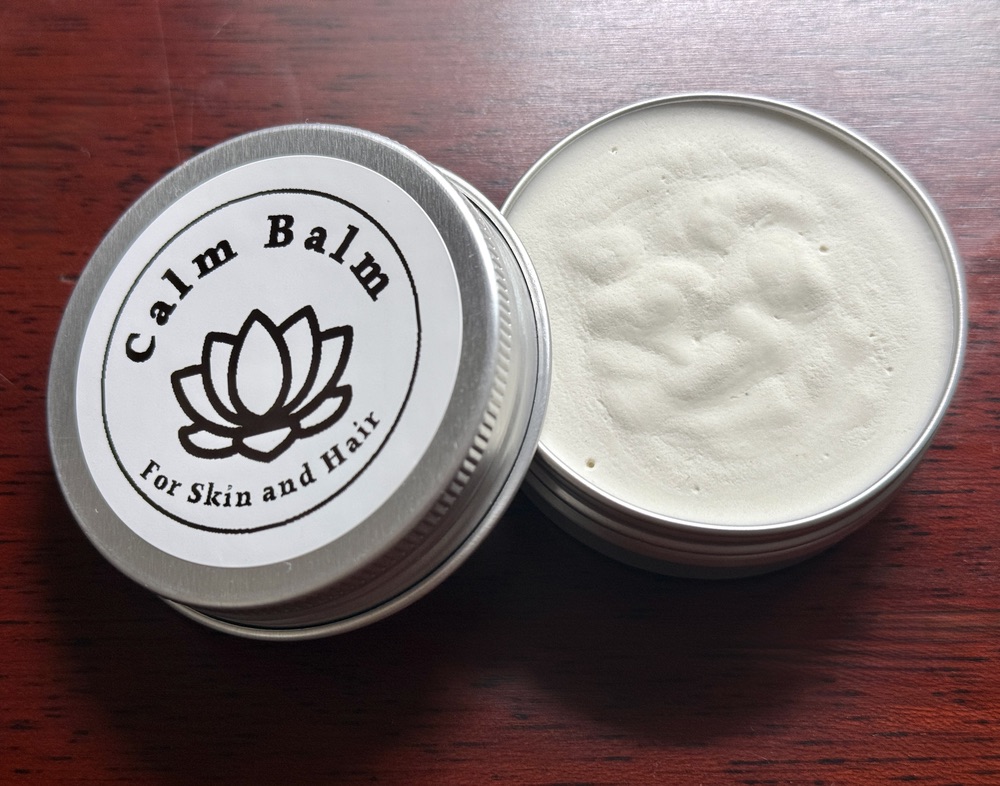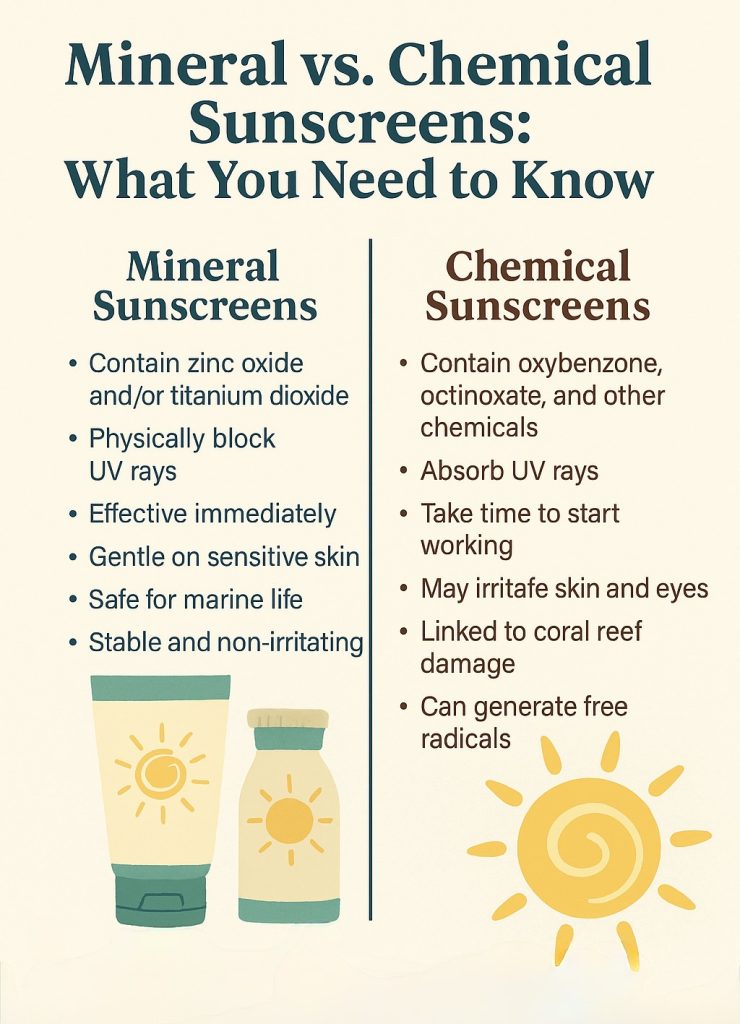Mineral vs. Chemical Sunscreens: What You Should Know About Health, Safety, and the Environment
Not all sun protection is created equal. The two main types of sunscreens: mineral (barrier) and chemical. They function differently, impact the body in different ways, and have very different effects on marine life. Understanding the difference is key to making an informed choice for your skin and the planet.
Let’s break down what separates them and why zinc oxide stands out as the safest and most sustainable choice.
Mineral (Barrier) Sunscreens: What They Are and How They Work
Mineral sunscreens, also called physical or barrier sunscreens, use natural minerals like:
- Zinc oxide
- Titanium dioxide
These minerals sit on top of the skin and physically block or reflect UV rays, preventing them from penetrating the skin. Because they don’t need to absorb into your skin, they begin working immediately upon application.
✅ Benefits of Zinc Oxide Sunscreen
Zinc oxide is widely regarded as the gold standard in safe sun protection.
1. Broad-Spectrum Protection
Zinc oxide provides full-spectrum protection from both UVA (aging) and UVB (burning) rays, something not all sunscreen ingredients do effectively. It is one of the few FDA-approved ingredients that blocks the entire UVA1 range (320–400 nm) [1].
2. Non-Toxic and Non-Irritating
Zinc oxide is not absorbed into the bloodstream. It sits on the skin’s surface, making it suitable for sensitive skin, including babies, people with rosacea, eczema, or acne-prone skin.
3. Anti-Inflammatory Properties
Zinc oxide has been used for decades in diaper creams and calamine lotion due to its soothing and anti-inflammatory effects [2].
4. Reef-Safe and Environmentally Friendly
Unlike many chemical sunscreens, non-nano zinc oxide is considered reef-safe. It does not contribute to coral bleaching and does not bioaccumulate in marine organisms.
5. Immediate Effectiveness
Mineral sunscreens begin working immediately upon application, as opposed to chemical filters which require 15–30 minutes to absorb.
Chemical Sunscreens: What They Are and How They Work
Chemical sunscreens contain organic (carbon-based) compounds that absorb UV rays, convert them to heat, and then release the heat from the skin. Common chemical UV filters include:
- Oxybenzone
- Octinoxate
- Avobenzone
- Octocrylene
- Homosalate
These ingredients must be absorbed into the skin to work, which often requiring reapplication more frequently, especially with water exposure.
⚠️ Health Concerns with Chemical Sunscreens
1. Systemic Absorption
Research published in JAMA (2020) showed that several chemical sunscreen ingredients—especially oxybenzone—were found in the bloodstream, urine, and breast milk after a single application [3].
2. Hormone Disruption
Oxybenzone is a known endocrine disruptor. It has been shown in lab studies to mimic estrogen and may interfere with hormone function, especially in children and developing fetuses [4].
3. Allergic Reactions and Irritation
Avobenzone and oxybenzone are common causes of contact dermatitis and phototoxic reactions, particularly in individuals with sensitive skin [5].
4. Photodegradation
Some chemical sunscreens (like avobenzone) break down when exposed to sunlight and must be stabilized with additional chemicals, potentially increasing the risk of irritation and sensitivity.
🌍 Environmental Hazards of Chemical Sunscreens
1. Coral Reef Destruction
Oxybenzone and octinoxate have been linked to coral bleaching, DNA damage in coral larvae, and impaired coral development [6]. These chemicals are now banned in places like Hawaii, the U.S. Virgin Islands, and Palau.
2. Toxic to Marine Life
Studies have found that even small concentrations (parts per trillion) of oxybenzone in water can cause deformities in fish, sea urchins, and dolphins [7].
3. Persistence in Ecosystems
Chemical UV filters are not easily biodegradable and have been found in wastewater, rivers, oceans, and even drinking water, leading to concerns about long-term ecological impacts.
Regulatory and Consumer Trends
- The FDA has approved only two sunscreen ingredients as Generally Recognized as Safe and Effective (GRASE): zinc oxide and titanium dioxide [8].
- The European Union has much stricter concentration limits for many chemical sunscreen filters than the U.S. due to safety concerns.
- Many consumers are now switching to mineral-based sunscreens, especially those labeled as “non-nano” zinc oxide, meaning particles are large enough not to penetrate skin or harm marine life.
How to Choose a Safer Sunscreen
Look for:
- Zinc oxide-based formulations
- Broad-spectrum and SPF 30+
- Non-nano and reef-safe labeling
- Avoid products containing oxybenzone, octinoxate, and octocrylene
ZINC-OXIDE Mineral SUNSCREEN Magnesium Infused Calm Balm 40g
Conclusion
While both chemical and mineral sunscreens offer UV protection, zinc oxide stands out as the safest and most environmentally responsible choice. It offers full-spectrum coverage, is non-toxic to humans and marine life, and starts working immediately. As research continues to highlight concerns about chemical UV filters, zinc oxide remains the best sunscreen active for both your skin and the planet.
Sources
- FDA. (2019). Proposed Rule: Sunscreen Drug Products for Over-the-Counter Human Use.
- Draelos, Z.D. (2007). Dermatologic uses of zinc oxide. Dermatologic Therapy.
- Matta, M.K., et al. (2020). Effect of Sunscreen Application on Plasma Concentration of Sunscreen Active Ingredients. JAMA.
- Krause, M. et al. (2012). Endocrine disrupting chemicals and UV filters. International Journal of Andrology.
- Schliemann-Willers, S. et al. (2002). Contact allergy to sunscreen. Contact Dermatitis Journal.
- Downs, C.A. et al. (2016). Toxicopathological effects of oxybenzone on coral planulae. Arch Environ Contam Toxicol.
- Tsui, M.M.P. et al. (2014). Occurrence and ecological risk assessment of UV filters in aquatic environments. Water Research.
- FDA. (2021). Sunscreen: Safety and Effectiveness.






Thanks for all the info.! Mineral sunscreen (zinc/titanium) is gentler on skin, protects instantly, and is reef-safe—unlike chemical sunscreens that absorb UV (and may irritate skin or harm marine life). It’s ideal for sensitive skin, kids, and eco-conscious users, though some formulas can leave a slight white cast. I made the switch years ago! I hope other people do too for their health and future!
Great breakdown! Mineral sunscreens (with zinc oxide or titanium dioxide) offer some underrated advantages:
✅ Gentler for sensitive skin – Less likely to cause irritation or allergic reactions.
✅ Immediate protection – Works as soon as it’s applied (no wait time!).
✅ More stable in sunlight – Doesn’t degrade as quickly as some chemical filters.
✅ Ocean-safe – Non-nano zinc oxide is reef-friendly, unlike oxybenzone/octinoxate.
For kids, eczema-prone skin, or outdoor workouts, I always recommend mineral!
Thoughts on the white cast issue? Newer formulations are improving this!
This is such a clear and helpful breakdown! I’ve always been confused about the difference, but your explanation of how they work (surface barrier vs. absorption) finally made it click for me. Thanks for the great info!
The point about mineral sunscreens being better for reactive skin is so true. I finally convinced my partner to try one, and his skin is so much happier. No more redness or breakouts after a day in the sun! Plus, mineral sunscreen is so much better for you and the environment!
Mineral suncreen is so much better for you and the environment. The choice is simple now. Some chemical suncreens have been linked to increasing your chance or cancer! Pretty scary! While mineral sunscreen actually improves skin and helps protect it. The choice is simple now.